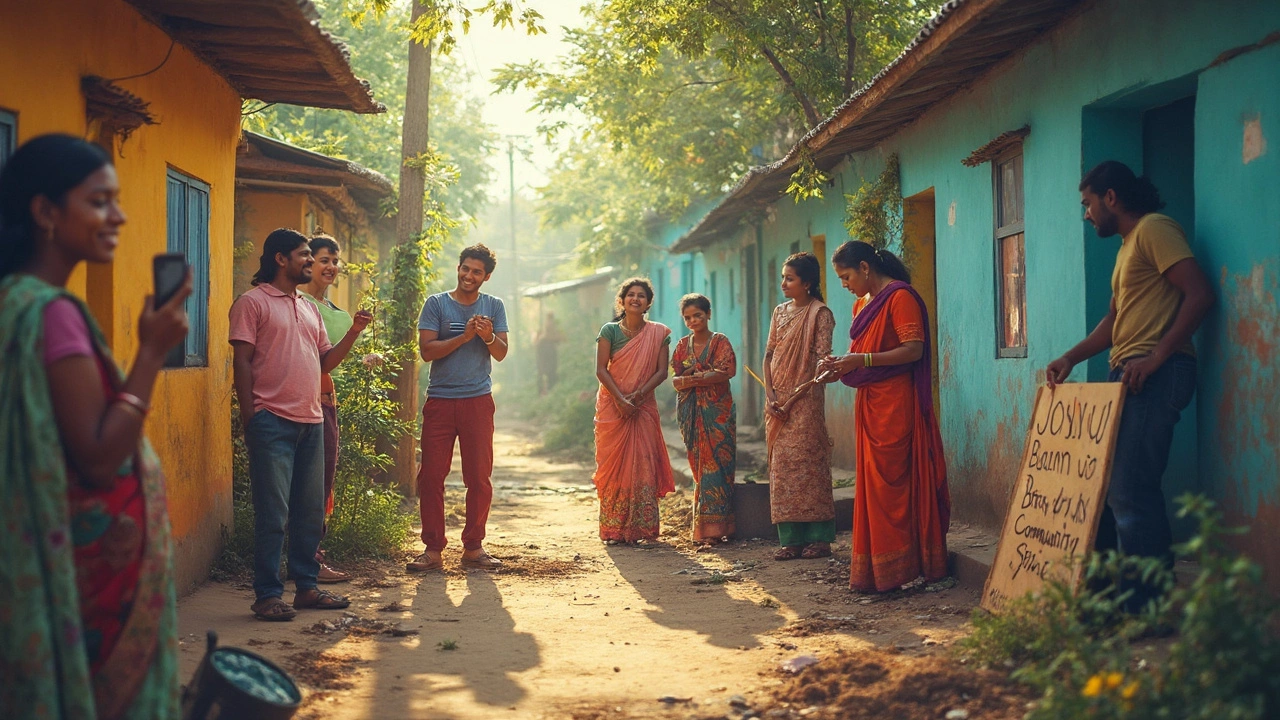Volunteering Decline: Causes, Impacts, and How to Turn the Tide
 Jun, 30 2025
Jun, 30 2025
2024 saw streets a bit emptier—fewer neighborhood cleanups, less friendly chatter at the food pantries, smaller crowds at volunteer days. It’s hard to miss: volunteering is dipping, and that’s both weird and a little worrying. Go back a decade, and volunteering almost felt like a rite of passage for anyone with free time or a weekend to spare. Schools, churches, and nonprofits were flooded with helpers, young and old. Now, organizations are literally begging for hands and hearts. What happened? Why is everyone so busy—or just not interested anymore? The answers aren’t just about busier schedules. They’re tangled up with changing priorities, the pressure of modern life, and a shift in how people want to give back. Ready for some uncomfortable truths—and some surprisingly hopeful ones?
The Hidden Reasons Volunteering Is Dropping Fast
The numbers don’t lie. A 2024 Gallup survey clocked U.S. volunteer rates at their lowest point since records began—just under 22 percent of adults took part in formal volunteering in the past year, compared to 28 percent in 2017. This isn’t just about getting lazy. People are stressed in new ways. The pandemic didn’t help. It torpedoed routines, shut down many in-person opportunities, and made a lot of folks nervous about face-to-face interactions, especially with vulnerable populations. Even now, many have stuck with online connections or remote work—leaving less energy for heading out into the world after Zoom fatigue sinks in.
Another curveball: the cost of living. Rents are creeping up, groceries eat up paychecks, student loans loom like a cloud. Free time? Sometimes it feels like no one has any. That’s real. When you’re grinding just to cover basics, showing up to stuff envelopes for a charity on a Tuesday night becomes a lot less practical. Recent Pew Research highlights this—over 40 percent of potential volunteers say work and personal obligations are the main deal-breakers.
But something else is shifting, too. Young people (hello, Gen Z) care deeply about causes—climate, social justice, animal rights—yet fewer of them sign up for traditional volunteering. Instead, you’ll catch them expressing activism in other ways: sharing a post, donating directly online, joining a protest. It’s not that they don’t care; it’s that the classic way of helping might not feel right for them. Nonprofits haven’t always responded to that. Some still expect folks to spend hours stuffing donation bags when the new generation wants to make a real impact—quickly and flexibly. If you’ve ever tried to volunteer and been buried under paperwork or bureaucracy, you’ll know how off-putting that is. Over 25 percent of would-be volunteers say slow or outdated procedures make them quit before they even start.
Let’s not forget burnout. People who do show up sometimes leave just as quick. When there’s a small crew covering everything because others aren’t showing up, the whole setup crumbles. It’s like being the last person at a party cleaning up spilled drinks alone—hardly anyone’s dream Saturday night. Add on top the lack of recognition—seriously, saying thank you changes so much—and you can see why dedicated helpers fade out, too.
Technology’s Double-Edged Sword
Technology has honestly changed the landscape. On the bright side, it’s easier than ever to find volunteer gigs—websites like VolunteerMatch, Idealist, and even LinkedIn filter opportunities by causes, skills, and time. But there's a catch: endless scrolling can make volunteering feel as transactional as ordering takeout. Quick sign-ups promise instant gratification, only for people to ghost when the real work calls. Human connection, the “spark” of face-to-face community work, is often lost in algorithms and online matching. Sometimes, you don’t even meet the people you’re helping.
We also live in a time when gamified apps and viral challenges stir people to act, sometimes briefly and in superficial ways. Remember the Ice Bucket Challenge? A month of hype raised awareness (and lots of cash for ALS, to be fair), but many participants never learned much about the cause itself. Fast-forward to 2025, and “set it and forget it” donations or hashtag campaigns often replace direct action. It’s impact—even if only for a few seconds—but doesn’t replace long-haul, boots-on-the-ground commitment like coaching a youth team or shelving donations at a food pantry week after week.
Digital volunteer work is on the rise. Online tutoring, crisis counseling via chat, website building for causes—these all count and can be life-changing. But not everyone finds these fulfilling. Video calls don’t usually provide the laughter, shared sweat, and messy realities people get from in-person service. If you’ve ever hauled boxes or painted a shelter wall next to a stranger, you know how quickly new friendships can form. A strong, hands-on sense of belonging—that’s hard to recreate in a chat window or email thread.
Plus, tech has a hidden downside: it’s easy to spread yourself thin. When you juggle work emails, family texts, and news alerts nonstop, adding “volunteer commitment” to the list sometimes feels impossible. People bounce off apps or ignore follow-up messages, leaving nonprofits scrambling for reliable help. Even seasoned volunteers sometimes ghost when digital overwhelm sets in.

Changing Values and the New Face of Volunteering
The question nobody likes to answer: has the spirit of helping faded? Actually, people want to help more than ever—but they want to do it on their own terms. A 2024 National Council on Nonprofits poll showed over 55 percent of respondents supported “micro-volunteering”—bite-sized, one-off helping gigs lasting an hour or less. This sort of volunteering works for overbooked parents, students juggling part-time gigs, or people who just want to dip a toe before diving deep. Think “packing 50 lunch bags for a shelter after work” or “editing a grant letter from your couch.”
Causes that feel personal are winning hearts. Animal rescues, bike repair co-ops, LGBTQ+ youth groups, mutual aid collectives—these often run on volunteers who have real skin in the game, not just a polite sense of duty. People want to see their impact up close, not just believe in it. My friend Sarah, for example, spends Saturdays at a refugee welcome center because she used to translate for her parents when they first arrived. The “why you’re here” matters deeply now, and sharing that story connects others to sign up, too.
Workplace cultures have changed, but not always in the right ways. Some companies bake volunteering into paid time off, letting staff walk dogs at shelters or plant gardens instead of sitting at a computer. But plenty don’t, or they organize “photo-op volunteering” where employees wear branded shirts and pose for a newsletter. These events can feel fake, and research from Boston College’s Center for Corporate Citizenship found employees are more likely to give back when they can choose causes that speak to them instead of signing up for whatever the boss says looks good on Instagram.
This all means traditional volunteering needs a makeover. Nonprofits that stay rigid—insisting on 6-month commitments or endless orientation slides—are getting left behind. The volunteering game is shifting toward flexibility, creativity, and bringing out what each person does best. That’s actually good news, if the old guard is willing to adapt.
How We Can Bring Volunteering Back—and Make It Mean Something
All is not lost. If the data tells one story, real people tell another. When folks find a cause they care about, a way to help that fits their life, and a team that actually appreciates them, they return—again and again. Here’s what has worked, in real life, to get people off the sidelines and back in the action:
- volunteering decline doesn’t mean people don’t care—it means organizations need to make it easier and more meaningful to jump in. Smaller tasks, “micro-volunteering” days, or virtual helping gigs let more people sample the experience. When Isaac wanted to help our neighborhood pantry, he signed up online to deliver groceries—one hour a month, no strings. That’s how busy lives get involved.
- Recognition matters way more than you’d think. Just getting a handwritten note, a phone call from a nonprofit director, or being mentioned at a meeting keeps people coming back. If you’re running a group, thank your volunteers more than you think you need to.
- Bring the social back. Volunteer events where people meet, share food, or even play music create that all-important fun factor. When helping out feels like hanging out, it’s contagious. Some of my best friendships started while planting trees on rainy Saturdays. I stuck around for the laughs as much as for the cause.
- Transparency builds trust. Volunteers don’t want to feel like cogs in a machine. Share the numbers, show results—did your event feed 200 more families this month? That’s a win. Make sure everyone knows the difference they made, right away.
- Update the sign-up process. Long forms and old-school orientation kill the mood. Quick applications, easy background checks, and a clear “here’s what you’ll do” outline remove friction. Make it as easy to volunteer as it is to order pizza.
- Let people use their skills. If you can code, design, organize, teach, or drive, match that skill to the right role. Nothing kills motivation like being given grunt work when you could make a real, unique difference.
- Get companies on board. Push for paid volunteer time and flexible team projects that support what employees care about—not just what’s good for optics. Business involvement grows when employees get to call some of the shots.
- Share stories that hit home. People respond to real humans, not just statistics. Spotlights on those who benefit, as well as fellow volunteers, multiply signups—nobody wants to feel like they’re showing up alone.
- If you’re thinking about volunteering, remember: an hour counts, virtual projects matter, and you don’t have to be a superhero. Start small, with something personal. Bring a friend—it’s easier and way more fun.
Volunteering doesn’t have to mean massive time commitments or lifelong pledges. The ripples from even tiny acts can be huge. Sure, the methods have changed, but the heart of the movement is still there, waiting for a jumpstart. Whether you sign up for ten minutes or ten years, you’re part of rebuilding something way bigger than yourself. And honestly, that’s one of the best feelings there is.